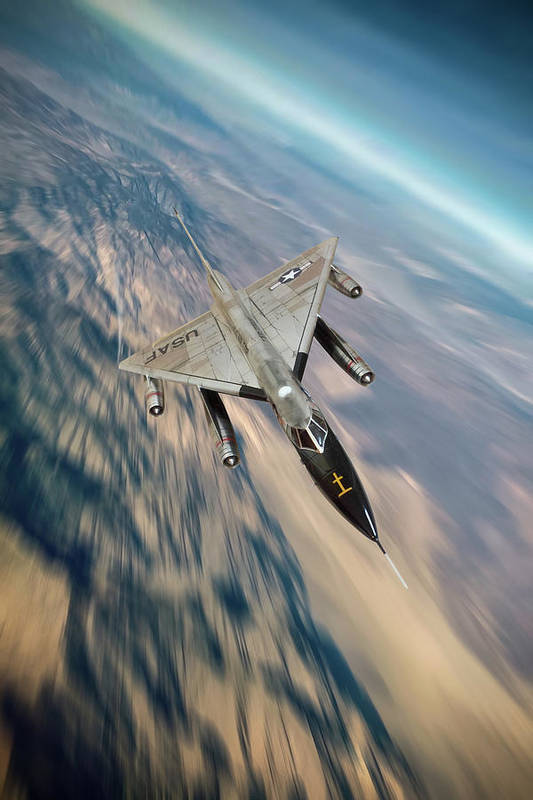
The USAF’s delta-winged Convair B-58 Hustler was the first supersonic bomber to enter service, in the summer of 1960, but only 116 were built, 30 for development and 86 for combat duty. Nevertheless, it remains a significant aircraft. It was the first bomber to reach a speed of Mach 2; the first aircraft constructed mainly from stainless-steel honeycomb sandwich; the first bomber to carry its payload in a jettisonable pod, which also contained the fuel for the outward journey; the first to incorporate a stellar-inertial navigation system; and the first to use the escape capsule concept, in which the crew of three sat in individual capsules which could be ejected in an emergency even at supersonic speed.
B-58A 59-2447 “Rapid Rabbit”
B-58A 60-1119 “City of Kokomo”
B-58A 59-2451 “The Firefly”
B-58A 59-2428 “Ben Hur”
B-58A 58-1016 “Champion of Champions” (as marked for the Jimmy Stewart promotional film)
B-58A 59-2430 (early Carswell AFB scheme with red chevron on tail)
B-58A 58-1009 “Bonanza / El Toro de Moron”
B-58A 59-2461 “Hoosier Hustler”
B-58A 59-2458 “Star Raker” (Bendix Trophy Winner)
B-58A 61-2053 2nd BW “winged 2” on tail
B-58A 59-2435 “Shackbuster”
B-58A 55-0660 Convair first flight scheme
B-58A 55-0662 Convair later eval scheme
TB-58 55-0662 XB-70 chase aircraft
B-58A 55-0661 ARDC
B-58A 55-0662 ARDC
B-58A 55-0665 ARDC
B-58A 59-2428 “Project Bullseye” SEA camouflage
Both the United States and the Soviet Union invested heavily in supersonic long-range bombers in the 1960s; the U. S. Convair B-58 Hustler and the Soviet Tupolev TU-22 Blinder were comparable in this regard. The planned replacements for the U. S. Air Force’s and Soviet Union’s strategic bomber fleets, the North American XB-70 Valkyrie and the experimental Myasishchev M-50 Bounder, were indicators of what direction bomber design was supposed to go, but cost, vulnerability, and technological limitations led to both aircraft being canceled by the 1970s.
The development of what became the supersonic Convair B-58 Hustler began in 1949, and the aircraft’s basic Delta-winged configuration was finalized in January 1951. The USAF’s operational requirement was issued that December, and the design was selected for production in October (beating a competing B-59 design offered by Boeing). At that stage, it was expected that there would also be a dedicated reconnaissance version of the aircraft.
The B-58 Hustler was designed for Mach 2 performance, it had an area-ruled fuselage and made considerable use of bonded honeycomb sandwich panels for temperature resistance. The four J79-GE-1 engines were hung below the thin wing, while weapons were carried in a massive ventral pod, which also housed 4,172 US gal (15,792 litres) of fuel. Despite its high performance, the B-58 Hustler was fitted with a defensive 20-mm cannon in the tailcone. The aircraft carried a crew of three in tandem seated in individual cockpits. One special feature of the B-58 was the individual escape capsules fitted for crew members to use in emergencies while flying at supersonic speeds.
The XB-58 prototype made its maiden flight on November 11, 1956 (less its pod, which was flown under the aircraft from February 16, 1957). The 13 YB-58s were followed by 17 YB-58As (the last of which was completed to full production standards). During the extensive flight test program, which involved 30 aircraft, a total of seven aircraft were lost. Production orders were placed for 86 further Convair B-58As. There were 11 YB-58As later brought up to the same standards. Production of the B-58As ceased in the Fall of 1962.
Modifications were made to eight of the trials aircraft to convert them into dual-control trainers. These had dual controls and extra transparencies in the second (rear) cockpit. The first of these flew on May 10, 1960.
The aircraft began to be delivered to the Strategic Air Command’s 43rd Bomb Wing at Carswell Air Force Base, Texas, in December 1959. The first squadron then became operational in March 1960. Hustlers were subsequently delivered to the 305th Wing in May 1961. But while many were impressed by the B-58’s performance, and by the succession of record-breaking flights (including New York-Paris and Tokyo-London) the aircraft had an atrocious accident rate (with 18 lost in service!). It was viewed by many as being a profligate waste of money, since each one cost more than three B-52Gs.
The final nail in the Convair B-58’s coffin came with the switch from high-level to low altitude penetration, since the B-58’s low level performance was hampered by its short range and relatively flimsy wing structure, the first Convair B-58 Hustler was retired in November 1969, and all had been retired by January 1970.